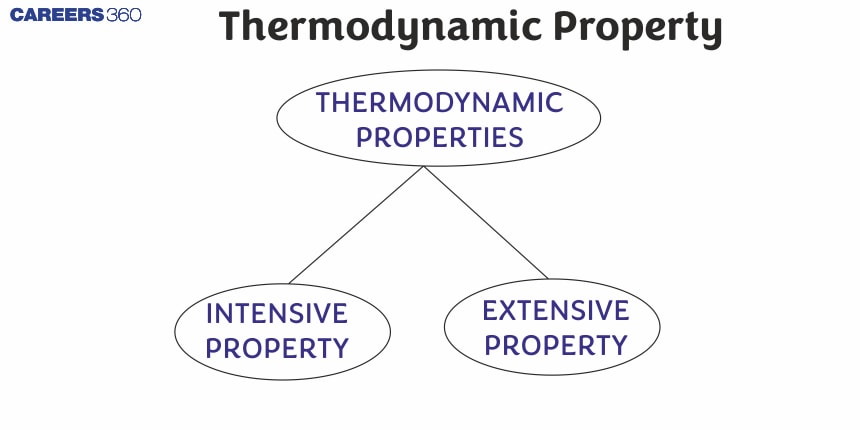Thermodynamic Property
We learn that thermodynamics is the branch of Physics and Chemistry that deals with heat, temperature, work, and their relation to energy, radiation, and the physical properties of matter. Thermodynamics deals with large systems. We can see the concept of thermodynamics applied in our everyday lives in cars, bikes, ACs, thermal flasks, refrigerators, washing machines, and many more.
This Story also Contains
- Properties of System
- 2. Extensive Properties
- Some Solved Examples
- Summary

There are plenty of characteristics and concepts in thermodynamics that help in defining the system. Multiple external and internal properties contribute to the result in terms of performance and reflect back on the total energy of the system. There exist many measurable properties of the thermodynamic system that help describe the current physical state of the system. These properties define the characteristic features of a system. Thermodynamic properties can be applied to energy systems and thermal or nuclear power plants. This article allows us to understand in detail the thermodynamic properties of the system.
Properties of System
All macroscopic properties of a system irrespective of the fact whether they are state variables or not are divided into two types:
1. Intensive Properties
Such properties remain the same on any division in the system that is, do not depend upon the amount of substance present in the system.
Example: Temperature, pressure, concentration, density, viscosity, surface tension, specific heat, refractive index, pH, EMF of the dry cell, vapor pressure, dipole-moment etc.
2. Extensive Properties
Such properties depend upon the amount of substance that is, their values are different in the divided system than in the entire system
Examples, Mass, volume, energy, work, internal energy, entropy, enthalpy, heat capacity, and length.
An extensive property can be made intensive specifying it in unit amount of matter.
Example, Density ≈( Mass Volume )
Recommended topic video on(Thermodynamic property)
Some Solved Examples
Example 1: Which of the following is an extensive property?
1) Enthalpy
2)Concentration
3)Density
4)Viscosity
Solution
Extensive Properties - Such properties depend upon the amount of substance that is, their values are different in the divided system than in the entire system Examples are mass, volume, energy, work, internal energy, entropy, enthalpy, heat capacity, and length. An extensive property can be made intensive specifying its In-unit amount of matter.
Example, Density ≈( Mass Volume )
Therefore we can say enthalpy depends upon the quantity of substance.
Hence, the correct answer is the option (1).
Example 2: Identify intensive property from the following
1)Volume
2)Mass
3)Enthalpy
4) Temperature
Solution
The properties that do not depend upon the quantity of matter present in the system or the size of the system are called intensive properties. For example temperature, pressure, concentration, density, dipole moment, refractive index, etc. Therefore we can say the temperature is independent of the mass of the substance.
Hence, the correct answer is option (4).
Example 3: Entropy of a pure substance is an ____________
1)point function
2)extensive property
3)intensive property
4)none of the mentioned
Solution
The entropy of a substance is an extensive property as it depends upon the amount of system taken.
Hence, the correct answer is the option (2).
Example 4: Which among the following is extensive property?
1)density
2)temperature
3) enthalpy
4)specific heat capacity
Solution
Extensive Property - Properties of the system depend on mass or the size of the system. All types of energy, mass, length, total heat capacity. Enthalpy depends on the amount of the system.
Hence, the answer is the option (3).
Example 5: The intensive property among these quantities is
1)enthalpy
2) mass/volume
3)mass
4)Volume
Solution
Intensive Property - Properties of the system which does not depend on mass or the size of the system. Pressure, Temperature, Density, Molar heat capacity, Specific heat capacity, concentration, Dipole moment, Viscosity, Refractive index, pH, Surface tension, EMF of Dry cell, Specific gravity, R. Mass/Volume is independent of the amount of the system.
Hence, the answer is the option (2).
Summary
Temperature measures the average kinetic energy of particles in a substance and is essential for understanding heat transfer and energy changes. It’s commonly measured in Kelvin (K), Celsius (°C), or Fahrenheit (°F), with the Kelvin scale being crucial in scientific contexts. Pressure, the force per unit area exerted by gas molecules, is vital for describing the states of gases and liquids and is measured in units like Pascal (Pa) or atmosphere (atm). It plays a key role in the ideal gas law linking pressure, volume, temperature, and the number of molecules. Temperature measures how hot or cold something is and reflects the average kinetic energy of particles in a substance. It is fundamental in thermodynamics because it influences heat transfer and energy changes. Common units of temperature include Kelvin (K), Celsius (°C), and Fahrenheit (°F). The Kelvin scale is significant in scientific contexts, with absolute zero (0 K) being the point where particles have minimum kinetic energy.